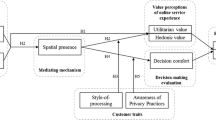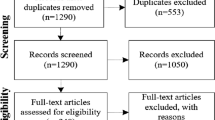Abstract
In the not-so-distant world in which ambient displays will likely become prevalent, immediate awareness of their interaction affordances to passerbies will be decisive for their usability. However, how to address awareness at user perception level represents a challenge for which little progress has been made so far in contrast with considerable advances in designing interaction techniques for such displays. Even though many interactive ambient displays exist with properly designed interfaces, people may not always be aware of their interactivity. This work addresses the problem of interactivity awareness by focusing on two important questions: How can people tell whether a public display is interactive or not? and, assuming interactivity, How can people tell what the interface is? A study was conducted in order to investigate factors potentially related to perceived interactivity. Results show that people’s evaluations are correct in most cases but they also tend to form incorrect perceptions in many other situations. We found that location, installation, reachability, and displayed content are factors that can influence people’s perceptions. Our findings are complemented with a discussion of techniques that can be used in the practice of designing for interactivity awareness.





Similar content being viewed by others
Notes
The mode is the response that occurs with the highest frequency between all participants’ responses for a given display.
Kendall’s W concordance coefficient takes values in the [0..1] domain, with 1 denoting perfect concordance and 0 absolute no agreement between the participants’ responses.
Cramer’s V statistic measures the strength of association between two categorical variables, taking values in [0..1] where 0 means no association while 1 denotes perfect association.
References
Agamanolis S (2002) Designing displays for human connectedness. Workshop on Public, Community and Situated Displays at CSCW’02, New Orleans
Ballagas R, Rohs M, Sheridan JG, Borchers J (2004) BYOD: Bring Your Own Device. Proc. of Ubiquitous Display Environments at Ubicomp 2004, September 7–10 Nottingham, UK
Ballagas R, Rohs M, Sheridan JG (2005) Sweep and point and shoot: phonecam-based interactions for large public displays. In: Proc. of CHI '05 Extended Abstracts, pp. 1200–1203. ACM, New York, NY, USA, doi:10.1145/1056808.1056876
Ballagas R, Borchers J, Rohs M, Sheridan JG (2006) The Smart Phone: a ubiquitous input device. IEEE Pervasive Computing 5:1
Baraldi S, Bimbo A, Landucci L (2008) Natural interaction on tabletops. Multimedia Tools Appl 38(3):385–405. doi:10.1007/s11042-007-0195-7
Block F, Schmidt A, Villar N, Gellersen H-W (2004) Towards a Playful User Interface for Home Entertainment Systems. In: Proc. of Ami’04, pp. 207–217. Springer
Boring S, Jurmu M, Butz A (2009) Scroll, tilt or move it: using mobile phones to continuously control pointers on large public displays. In: Proc. of OZCHI '09, vol. 411, pp. 161–168. ACM, New York, NY
Brignull H, Rogers Y (2003) Enticing people to interact with large public displays in public spaces. In: Proc. of INTERACT’03, pp. 17–24
Campbell SW (2007) Perceptions of mobile phone use in public settings: a cross-cultural comparison. Int J Comm 1:738–757
Dachselt R, Buchholz R (2009) Natural throw and tilt interaction between mobile phones and distant displays. In: Proc. of CHI '09, pp. 3253–3258. ACM, New York, NY, USA
Dovgan E, Lustrek M, Pogorelc B, Gradisek A, Burger H, Gams M (2011) Intelligent elderly-care prototype for fall and disease detection from sensor data. Zdravniski Vestnik-Slovenian Medical Journal 80(11):824–831
Echtler F, Nestler S, Dippon A, Klinker G (2009) Supporting casual interactions between board games on public tabletop displays and mobile devices. Personal Ubiquitous Comput 13(8):609–617. doi:10.1007/s00779-009-0246-3
Fogarty J, Hudson SE, Atkeson CG, Avrahami D, Forlizzi J, Kiesler S, Lee JC, Yang L (2005) Predicting human interruptibility with sensors. ACM Trans Comput Hum Interact 12(1):119–146. doi:10.1145/1057237.1057243
Gibbs WW (2005) Considerate computing. Sci Am 292(1):54–61
Greenfield A (2006) Everyware: The Dawning Age of Ubiquitous Computing. New Riders Publishing, 1st Edition
Gustafson S, Bierwidth D, Baudisch P (2010) Imaginary Interfaces: Spatial Interaction with Empty Hands and Without Visual Feedback. In: Proc. of UIST 2010, pp. 3–12. ACM Press, New York, NY
Harper R, Rodden T, Rogers Y, Sellen A (2008) Being Human. Human-Computer Interaction in the year 2020. Microsoft Research Ltd, Cambridge, England
Hinckley K, Pierce J, Sinclair M, Horvitz E (2000) Sensing techniques for mobile interaction. In: Proc. of UIST '00, pp. 91–100. ACM, New York, NY, USA
Ishii H (2008) Tangible bits: beyond pixels. In Proceedings of the 2nd international conference on Tangible and embedded interaction (TEI '08). ACM, New York, NY, USA, doi:10.1145/1347390.1347392
Jota R, Nacenta MA, Jorge JA, Carpendale S, Greenberg S (2010) A comparison of ray pointing techniques for very large displays. In: Proceedings of Graphics Interface 2010 (GI '10). Canadian Information Processing Society, Toronto, Ont., Canada, Canada, 269–276
Ju W, Leifer L (2008) The design of implicit interactions: making interactive systems less obnoxious. Design Issues 24(3):72–84
Kray C, Galani A, Rohs M (2008) Facilitating Opportunistic Interaction with Ambient Displays. In: Proc. of Workshop on Designing and Evaluating Mobile Phone-Based Interaction with Public Displays at CHI’08
Lantz E (2007) A survey of large-scale immersive displays. In: Proceedings of the 2007 workshop on Emerging displays technologies: images and beyond: the future of displays and interacton (EDT '07). ACM, New York, NY, USA, doi:10.1145/1278240.1278241
Lee JC (2008) Hacking the Nintendo Wii Remote. IEEE Perv Computing 7(3):39–45
Lepinski J, Vertegaal R (2010) Cloth displays: interacting with drapable textile screens. In: Proceedings of the fifth international conference on Tangible, embedded, and embodied interaction (TEI '11). ACM, New York, NY, USA, 285–288, doi:10.1145/1935701.1935765
Lugmayr A, Risse T, Stockleben B, Laurila K, Kaario J (2009) Semantic ambient media—an introduction. Multimedia Tools and Applications 44(3):337–359. doi:10.1007/s11042-009-0282-z
Mcluhan M (1994) Understanding Media: The Extensions of Man. MIT Press
Mistry P, Maes P, Chang L (2009) WUW - wear Ur world: a wearable gestural interface. In: Proc. of CHI’09 Extended Abstracts, pp. 4111–4116. ACM, New York, NY
Miyaoku K, Higashino S, Tonomura Y (2004) C-blink: a hue-difference-based light signal marker for large screen interaction via any mobile terminal. In: Proc. Of UIST '04, pp. 147–156. ACM, New York, NY, USA, doi:10.1145/1029632.1029657
Myers BA, Stiel H, Gargiulo R (1998) Collaboration using multiple PDAs connected to a PC. In: Proc. of CSCW '98, pp. 285–294. ACM, New York, NY, USA, doi:10.1145/289444.289503
Patel SN, Abowd GD (2003) A 2-Way Laser-Assisted Selection Scheme for Handhelds in a Physical Environment. In: Dey AK et al. (eds), Proc. of Ubi-Comp’03, LNCS 2864, pp. 200–207, Springer Verlag Berlin
Patel SN, Pierce JS, Abowd GD (2004) A gesture-based authentication scheme for untrusted public terminals. In: Proc. of UIST '04, pp. 157–160. ACM, New York, NY, USA, doi:10.1145/1029632.1029658
Peiris RL, Cheok AD, Teh JKS, Fernando ONN, Yingqian W, Lim A, Yi P, Polydorou D, Ong KP, Tharakan M (2009) AmbiKraf: an embedded non-emissive and fast changing wearable display. In ACM SIGGRAPH 2009 Emerging Technologies (SIGGRAPH '09). ACM, USA, doi:10.1145/1597956.1597957
Peltonen P, Kurvinen E, Salovaara A, Jacucci G, Ilmonen T, Evans J, Oulasvirta A, Saarikko P (2008) It’s Mine, Don’t Touch!: interactions at a large multi-touch display in a city centre. In: Proceedings of the twenty-sixth annual SIGCHI conference on Human factors in computing systems (CHI '08). ACM, New York, NY, USA, 1285–1294. doi:10.1145/1357054.1357255
Petrescu S, Chera C (2011) A Service Oriented Model for Building Control and Simulation. In: Proc. of the 18th International Conference on Control Systems and Computer Science
Popovici DM, Polceanu M (2008) Interactive Informative Unit Based on Augmented Reality Technology. In: Proceedings of the 3rd International Conference on Virtual Learning, 307–316
Pogorelc B, Bosnic Z, Gams M (2011) Automatic recognition of gait-related health problems in the elderly using machine learning. Multimed Tools Appl. doi:10.1007/s11042-011-0786-1
Pogorelc B, Vatavu RD, Lugmayr A, Stockleben B, Risse T, Kaario J, Lomonaco EC, Gams, M (2012) Semantic Ambient Media: From Ambient Advertising to Ambient-Assisted Living. Multimedia Tools and Applications, Springer, doi:10.1007/s11042-011-0917-8
Rakkolainen IK, Lugmayr A (2007) Immaterial display for interactive advertisements. In Proceedings of the international conference on Advances in computer entertainment technology (ACE '07). ACM, New York, NY, USA, 95–98. doi:10.1145/1255047.1255066
RemotePad for iPhone, http://www.tenjin.org/RemotePad/, last accessed March 2012
Rico J, Brewster S (2009) Gestures all around us: user differences in social acceptability perceptions of gesture based interfaces. In: Proc. of MobileHCI '09. ACM, New York, NY, USA
Rico J, Brewster S (2010) Usable gestures for mobile interfaces: evaluating social acceptability. In: Proc. of CHI '10, pp. 887–896. ACM, New York, NY, USA
Saffer D (2009) Designing gestural interfaces. O’Reilly Media Inc., Canada
Shoemaker G, Tang A, Booth KS (2007) Shadow reaching: a new perspective on interaction for large displays. In: Proc. of UIST '07, pp. 53–56. ACM, New York, NY
Silfverberg M, MacKenzie S, Kauppinen T (2001) An isometric joystick as a pointing device for handheld information terminals. In: Graphics Interface 2001, pp. 119–126. Canadian Information Processing Society, Toronto, Ont., Canada, Canada
Sippl A, Holzmann C, Zachhuber D, Ferscha A (2010) Real-Time Gaze Tracking for Public Displays. In: Proc. of Ami’2010. LNCS 6439/2010, pp. 167–176, doi:10.1007/978-3-642-16917-5_17
Song Y, Demirdjian D, Davis R (2012) Continuous body and hand gesture recognition for natural human-computer interaction. ACM Trans. Interact. Intell. Syst. 2, 1, Article 5 (March 2012), doi:10.1145/2133366.2133371
Streitz N, Röcker C, Prante T, Stenzel R, van Alphen D (2003) Situated Interaction with Ambient Information: Facilitating Awareness and Communication in Ubiquitous Work Environments. In: Proc. of HCI International
Vatavu RD (2009) Interfaces That Should Feel Right: Natural Interaction with Multimedia Information. In: M. Grgic, K. Delac, M. Ghanbari (Eds): Recent Advances in Multimedia Signal Processing and Communications, vol. 231/2009, pp. 145–170, Springer Berlin / Heidelberg, doi:10.1007/978-3-642-02900-4_7
Vatavu RD (2011) Presence Bubbles: Supporting and Enhancing Human-Human Interaction with Ambient Media, Multimedia Tools and Applications, Springer Netherlands, doi:10.1007/s11042-010-0674-0
Vatavu RD (2011) Point & click mediated interactions for large home entertainment displays. Multimedia Tools and Applications, Springer, doi:10.1007/s11042-010-0698-5
Vatavu RD (2012) Nomadic gestures: A technique for reusing gesture commands for frequent ambient interactions. Journal of Ambient Intelligence and Smart Environments 4(2):79–93. doi:10.3233/AIS-2012-0137
Vogel D, Balakrishnan R (2004) Interactive public ambient displays: transitioning from implicit to explicit, public to personal, interaction with multiple users. In: Proc. of UIST '04, pp. 137–146. ACM, New York, NY
Vogel D, Balakrishnan R (2005) Distant freehand pointing and clicking on very large, high resolution displays. In: Proc. of UIST’05, pp. 33–42. ACM, New York, NY
Wang J, Zhai S, Canny J (2006) Camera phone based motion sensing: interaction techniques, applications and performance study. In: Proc. of UIST '06, pp. 101–110. ACM, New York, NY, USA
Wilson AD, Sarin R (2007) BlueTable: connecting wireless mobile devices on interactive surfaces using vision-based handshaking. In: Proceedings of Graphics Interface 2007 (GI '07). ACM, New York, NY, USA, 119–125, doi:10.1145/1268517.1268539
Yin Y, Davis R (2010) Toward natural interaction in the real world: real-time gesture recognition. In International Conference on Multimodal Interfaces and the Workshop on Machine Learning for Multimodal Interaction (ICMI-MLMI '10). ACM, New York, NY, USA, doi:10.1145/1891903.1891924
Acknowledgments
This paper was supported by the project “Progress and development through post-doctoral research and innovation in engineering and applied sciences- PRiDE - Contract no. POSDRU/89/1.5/S/57083”, project co-funded from European Social Fund through Sectorial Operational Program Human Resources 2007–2013.
Author information
Authors and Affiliations
Corresponding author
Rights and permissions
About this article
Cite this article
Vatavu, RD. On designing interactivity awareness for ambient displays. Multimed Tools Appl 66, 59–80 (2013). https://doi.org/10.1007/s11042-012-1140-y
Published:
Issue Date:
DOI: https://doi.org/10.1007/s11042-012-1140-y




